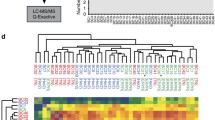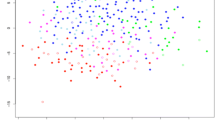Abstract
Expression profiling of RNAs or proteins has become a promising means to investigate the heterogeneity of histopathologically defined classes of cancer. Peptides, representing degradation as well as processing products of proteins offer an even closer insight into cell physiology. Peptides are related to the turnover of cellular proteins and are capable to reflect disease-related changes in homoeostasis of the human body. Furthermore, peptides derived from tumor cells are potentially useful markers in the early detection of cancer.
In this study, we introduced a method called differential peptide display (DPD) for separating, detecting, and identifying native peptides derived from whole cell extracts. This method is a highly standardized procedure, combining the power of reversed-phase chromatography with mass spectrometry. This technology is suitable to analyze cell lines, various tissue types and human body fluids. Peptide-based profiling of normal human mammary epithelial cells (HMEC) and the breast cancer cell line MCF-7 revealed complex peptide patterns comprising of up to 2300 peptides. Most of these peptides were common to both cell lines whereas about 8% differed in their abundance. Several of the differentially expressed peptides were identified as fragments of known proteins such as intermediate filament proteins, thymosins or Cathepsin D. Comparing cell lines with native tumors, overlapping peptide patterns were found between HMEC and a phylloides tumor (CP) on the one hand and MCF-7 cells and tissue from a invasive ductal carcinoma (DC) on the other hand.
Similar content being viewed by others
References
Alizadeh AA, Ross DT, Perou CM, van de RM: Towards a novel classification of human malignancies based on gene expression patterns. J Pathol 195: 41–52, 2001
Perou CM, Sorlie T, Eisen MB, van de RM, Jeffrey SS, Rees CA, Pollack JR, Ross DT, Johnsen H, Akslen LA, Fluge O, Pergamenschikov A, Williams C, Zhu SX, Lonning PE, Borresen-Dale AL, Brown PO, Botstein D: Molecular portraits of human breast tumours. Nature 406: 747–752, 2000
Zhang L, Zhou W, Velculescu VE, Kern SE, Hruban RH, Hamilton SR, Vogelstein B, Kinzler KW: Gene expression profiles in normal and cancer cells. Science 276: 1268–1272, 1997
DeRisi J, Penland L, Brown PO, Bittner ML, Meltzer PS, Ray M, Chen Y, Su YA, Trent JM: Use of a cDNA microarray to analyse gene expression patterns in human cancer. Nat Genet 14: 457–460, 1996
Hedenfalk I, Duggan D, Chen Y, Radmacher M, Bittner M, Simon R, Meltzer P, Gusterson B, Esteller M, Kallioniemi OP, Wilfond B, Borg A, Trent J: Gene-expression profiles in hereditary breast cancer. N Engl J Med 344: 539–548, 2001
Russell A, Thompson MA, Hendley J, Trute L, Armes J, Germain D: Cyclin D1 and D3 associate with the SCF complex and are coordinately elevated in breast cancer. Oncogene 18: 1983–1991, 1999
Ozturk M, Bolkent S, Yilmazer S, Kaner G, Unal H: Detection of c-erbB-2 mRNAs using dig-labelled oligonucleotide probe with in situ hybridisation in human breast carcinoma: comparison with immunohistochemical results. Anal Cell Pathol 16: 201–209, 1998
Schulz-Knappe P, Zucht HD, Heine G, Jurgens M, Hess R, Schrader M: Peptidomics: the comprehensive analysis of peptides in complex biological mixtures. Comb Chem High Throughput Screen 4: 207–217, 2001
Le Naour F, Misek DE, Krause MC, Deneux L, Giordano TJ, Scholl S, Hanash SM: Proteomics-based identification of RS/DJ-1 as a novel circulating tumor antigen in breast cancer. Clin Cancer Res 7: 3328–3335, 2001
Carr SA, Hemling ME, Bean MF, Roberts GD: Integration of mass spectrometry in analytical biotechnology. Anal Chem 63: 2802–2824, 1991
Annan RS, Carr SA: Phosphopeptide analysis by matrixassisted laser desorption time-of-flight mass spectrometry. Anal Chem 68: 3413–3421, 1996
Chong BE, Hamler RL, Lubman DM, Ethier SP, Rosenspire AJ, Miller FR: Differential screening and mass mapping of proteins from premalignant and cancer cell lines using nonporous reversed-phase HPLC coupled with mass spectrometric analysis. Anal Chem 73: 1219–1227, 2001
Vlahou A, Schellhammer PF, Mendrinos S, Patel K, Kondylis FI, Gong L, Nasim S, Wright Jr JG: Development of a novel proteomic approach for the detection of transitional cell carcinoma of the bladder in urine. Am J Pathol 158: 1491–1502, 2001
Adam BL, Vlahou A, Semmes OJ, Wright Jr GL: Proteomic approaches to biomarker discovery in prostate and bladder cancers. Proteomics 1: 1264–1270, 2001
Schild H, Rammensee HG: Perfect use of imperfection. Nature 404: 709–710, 2000
Schrader M, Schulz-Knappe P: Peptidomics technologies for human body fluids. Trends Biotechnol 19: 55–60, 2001
Tammen H, Hess R, Ueckert S, Becker AJ, Stief CG, Schulz-Knappe P, Schrader M, Jonas U: Detection of lowmolecular-mass plasma peptides in the carvenous and systemic blood of healthy men during penile flaccidity and rigidity-an experimental approach using the novel differential peptide display technology. Urology 59: 784–789, 2002
Yates III JR: Mass spectrometry and the age of the proteome. J Mass Spectrom 33: 1–19, 1998
Perkins DN, Pappin DJ, Creasy DM, Cottrell JS: Probabilitybased protein identification by searching sequence databases using mass spectrometry data. Electrophoresis 20: 3551–3567, 1999
Thompson DA, Weigel RJ: hAG-2, the human homologue of the Xenopus laevis cement gland gene XAG-2, is coexpressed with estrogen receptor in breast cancer cell lines. Biochem Biophys Res Commun 251: 111–116, 1998
Leto G, Gebbia N, Rausa L, Tumminello FM: Cathepsin D in the malignant progression of neoplastic diseases (review). Anticancer Res 12: 235–240, 1992
Liaudet E, Derocq D, Rochefort H, Garcia M: Transfected cathepsin D stimulates high density cancer cell growth by inactivating secreted growth inhibitors. Cell Growth Differ 6: 1045–1052, 1995
Rochefort H, Liaudet-Coopman E: Cathepsin D in cancer metastasis: a protease and a ligand. APMIS 107: 86–95, 1999
Schubert U, Anton LC, Gibbs J, Norbury CC, Yewdell JW, Bennink JR: Rapid degradation of a large fraction of newly synthesized proteins by proteasomes. Nature 404: 770–774, 2000
Schagger H, Von Jagow G: Tricine-sodium dodecyl sulfatepolyacrylamide gel electrophoresis for the separation of proteins in the range from 1 to 100 kDa. Anal Biochem 166: 368–379, 1987
Merchant M, Weinberger SR: Recent advancements in surface-enhanced laser desorption/ionization-time of flight-mass spectrometry. Electrophoresis 21: 1164–1177, 2000
Malzahn K, Mitze M, Thoenes M, Moll R: Biological and prognostic significance of stratified epithelial cytokeratins in infiltrating ductal breast carcinomas. Virchows Arch 433: 119–129, 1998
Trask DK, Band V, Zajchowski DA, Yaswen P, Suh T, Sager R: Keratins as markers that distinguish normal and tumorderived mammary epithelial cells. Proc Natl Acad Sci USA 87: 2319–2323, 1990
Aaltonen M, Lipponen P, Kosma VM, Aaltomaa S, Syrjanen K: Prognostic value of cathepsin-D expression in female breast cancer. Anticancer Res15: 1033–1037, 1995
Rochefort H, Chalbos D, Cunat S, Lucas A, Platet N, Garcia M: Estrogen regulated proteases and antiproteases in ovarian and breast cancer cells. J Steroid Biochem Mol Biol 76: 119–124, 2001
Vignon F, Capony F, Chambon M, Freiss G, Garcia M, Rochefort H: Autocrine growth stimulation of the MCF 7 breast cancer cells by the estrogen-regulated 52K protein. Endocrinology 118: 1537–1545, 1986
Tsukuba T, Okamoto K, Yasuda Y, Morikawa W, Nakanishi H, Yamamoto K: New functional aspects of cathepsin D and cathepsin E. Mol Cells 10: 601–611, 2000
Miyake Y, Kodama T, Yamaguchi K: Pro-gastrin-releasing peptide (31-98) is a specific tumor marker in patients with small cell lung carcinoma. Cancer Res 54: 2136–2140, 1994
Author information
Authors and Affiliations
Rights and permissions
About this article
Cite this article
Tammen, H., Kreipe, H., Hess, R. et al. Expression Profiling of Breast Cancer Cells by Differential Peptide Display. Breast Cancer Res Treat 79, 83–93 (2003). https://doi.org/10.1023/A:1023309621042
Issue Date:
DOI: https://doi.org/10.1023/A:1023309621042




